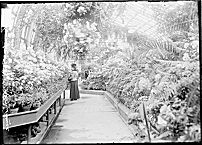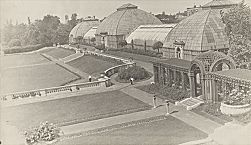| Entries |
| C |
|
Conservatories
|

|
The Lincoln Park Commission established a greenhouse in 1877 and planted an adjacent formal garden in 1880. The greenhouse was replaced with a much more substantial and exotic conservatory, designed by Joseph Lyman Silsbee and M. E. Bell. As the new conservatory was being constructed in stages between 1890 and 1895, an informal perennial garden, called Grandmother's Garden, was planted to its west.

|
Owing to political corruption within the West Park System, by the early 1900s the three glass houses in Humboldt, Douglas, and Garfield Parks were poorly maintained. In 1905, Jens Jensen was appointed as superintendent and chief landscape architect by a reform-minded board. He demolished all three conservatories to construct one centralized facility in Garfield Park, intended as the world's largest conservatory. Jensen, who is considered dean of the Prairie style in landscape architecture, developed a revolutionary design for the Garfield Park Conservatory. In contrast to most conservatories, which looked like palaces or chateaus, Jensen wanted the structure's form to emulate the “great haystacks” of the Midwest. His unique approach for the interior, considered “landscape gardening under glass,” featured compositions with open vistas surrounded by artfully arranged plantings.
Jensen's design improvements during theWest Park Commission's era of reform included outdoor gardens in Humboldt, Douglas, and Garfield Parks. These elaborately planted gardens combined Midwestern wildflowers with non-native annuals. To provide shady seating areas, Jensen used open shelters called pergolas in Humboldt and Garfield Parks and a larger Prairie-style building known as Flower Hall in Douglas Park. There are water features in all three gardens.
Chicago's suburbs include several other examples of historic gardens and one other conservatory. Among these are Jens Jensen's Shakespeare Garden (1915) and the Merrick Rose Garden, both located in Evanston. Gardener's Memorial in Highland Park was created to commemorate three local naturalists, including Jens Jensen. In Oak Park, a 1914 community effort had residents bringing back plants from foreign places. This culminated in the construction of the Oak Park Conservatory in 1929.
The Encyclopedia of Chicago © 2004 The Newberry Library. All Rights Reserved. Portions are copyrighted by other institutions and individuals. Additional information on copyright and permissions.